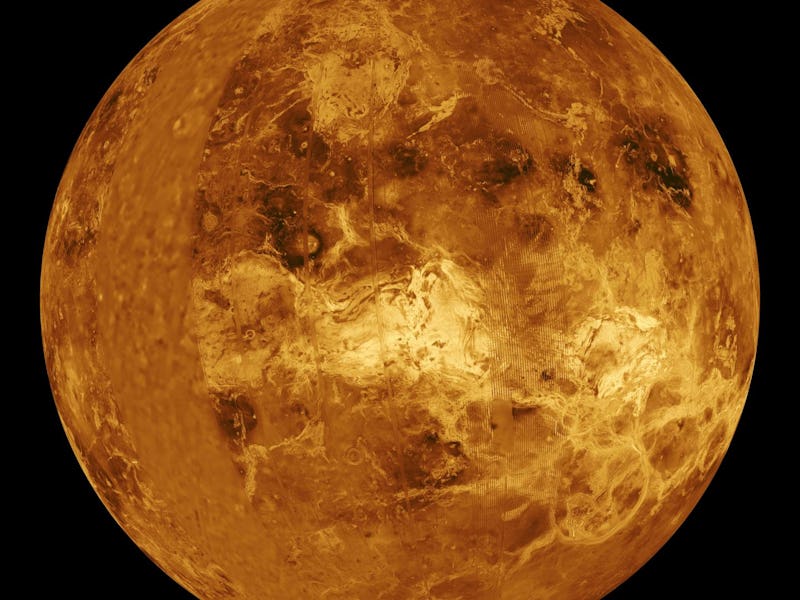Why does Venus’ atmosphere spin much faster than the planet?
This strange phenomenon has puzzled scientists for years, but they finally have an answer.

The closest planet to the Sun, Mercury, is known for its speed. The second planet from the Sun, Venus, could very well be known as its exact opposite. It takes this burning hot planet 243 Earth days to rotate once around its axis. However, Venus' atmosphere acts independently, taking only four Earth days to complete the same trip.
For nearly 60 years, scientists have pondered over this atmospheric super-rotation phenomenon but a recent study may have just cracked the code in Venus' clouds.
"Since the super-rotation was discovered in the 1960s...the mechanism behind its forming and maintenance has been a long-standing mystery," Takeshi Horinouchi, a professor at Hokkaido University, Japan, and lead author of the study, said in a statement.
An illustration showing Venus' atmosphere traveling at higher speeds than the planet.
The study, published Thursday in the journal Science, suggests that the reason why the Venusian atmosphere rotates at a much higher speed than the planet lies with atmospheric tidal waves. These tidal waves form as a result of heating by the Sun on the planet's dayside in contrast with its cooler temperatures on the nightside.
But the planet, famously named after the Roman goddess of love and beauty, contains even more mysteries shrouded in its thick clouds. Venus' atmosphere travels at speeds of around 200 meters per second, that's 60 times faster than the rotation of the planetary body itself.
This super-rotation is rather unique to Venus, having only been observed in Saturn's largest moon, the equally bizarre world of Titan.
In order to help resolve this issue, the team behind the new study used images obtained by the Akatsuki spacecraft. The spacecraft, also known as the Venus Climate Orbiter, was launched in May, 2010 by the Japan Aerospace Exploration Agency (JAXA) to explore the Venusian atmosphere. The spacecraft began orbiting Venus in December, 2015.
The team of scientists tracked clouds and obtained wind velocities from images that were captured by ultraviolet and infrared cameras on the Akatsuki spacecraft.
After analyzing the data, the scientists noticed a thermal tide, or a sort of atmospheric wave that was triggered by heating from the Sun near the planet's equator. The average temperature on Venus is 462 degrees Celsius, but things get cooler in the upper atmosphere, ranging from -43 to -173 Celsius.
This atmospheric wave on Venus speeds up the atmosphere's rotation at low altitudes, causing it to go much faster than the planet itself.
A diagram illustrating the mechanism by which Venus' atmosphere rotates at a higher speed than the planaet.
Scientists have often looked to Venus as a prototype for what might happen to Earth in the longterm future. The two planets share the same size and composition, and Venus may have looked like Earth at one point during its younger years, but its atmospheric changes led to the dry planet we observe today.
Therefore, studying Venus not only gives scientists insight regarding planets in the Solar System, it also provides an interesting case study of atmospheric science.
Venus could also be useful in studying bizarre exoplanets outside the Solar System.
"Our study could help better understand atmospheric systems on tidally-locked exoplanets whose one side always facing the central stars, which is similar to Venus having a very long solar day," Horinouchi said.
Abstract: Venus has a thick atmosphere that rotates 60 times as fast as the surface, a phenomenon known as superrotation. We use data obtained from the orbiting Akatsuki spacecraft to investigate how the super-rotation is maintained in the cloud layer, where the rotation speed is highest. A thermally induced latitudinal-vertical circulation acts to homogenize the distribution of the angular momentum around the rotational axis. Maintaining the super-rotation requires this to be counteracted by atmospheric waves and turbulence. Among those effects, thermal tides transport the angular momentum, which maintains the rotation peak, near the cloud top at low latitudes. Other planetary-scale waves and large-scale turbulence act in the opposite direction. We suggest that hydrodynamic instabilities adjust the angular-momentum distribution at mid-latitudes.